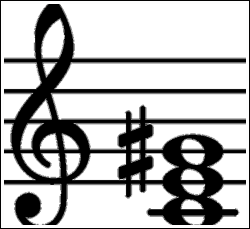
Augmented Triad (1–3-#5)
The augmented chord is the next chord build we’re going to take a look at. The numbers you see in parentheses after the title above (1–3–#5), indicate the spelling, or formula used to build an augmented triad. The formula is based on the major scale.
Therefore, an augmented triad is built using the 1st, 3rd and sharp 5th (#5) of the major scale.
*The augmented chord is the same as a major chord, except the 5th is raised by a semitone (half tone).
An augmented chord example
To build a C+ chord (Caug), let’s look at the C major scale and find our augmented triad (1–3-#5):

The notes of the C Major scale are depicted in black.
The root of our chord is the 1st, or tonic of the scale. That note is a “C”.
The 3rd is an “E”.
The 5th is a “G”, but we want to sharp the 5th (#5), so we raise it by a semitone to a “G#”.
Our C+ triad is C – E – G#.
So we can build a C+ chord just by using those notes. We can put them in any order (different inversions), and we can double up any note in the triad if we wish.
I won’t walk you through “building the chord” on your mandolin this time. If you want to try it yourself, or if you need help on how to do this, check out the previous articles on “The Major Chord” and ”The Minor Chord”.
But, I will show you 3 shapes for the Caug chord:
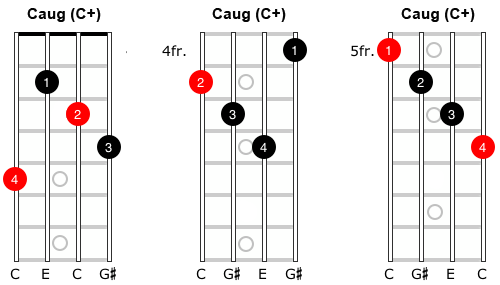
The augmented chord is unique
Aside from a few open string chords, the augmented chord has only 3 different shapes! And, each of those shapes is moveable.
Check this out
What if we want an Eaug chord?
Here’s the E major scale:

Our augmented triad formula is 1-3-#5. So the root of our chord is the 1st, which is an “E”.
The 3rd of the scale is G#.
The 5th is a B, and when we raise it a half tone to make it sharp, we get a B# (which is a C).
So the notes for our Eaug triad are E–G#-C.
If you haven’t noticed already, those are the exact same notes as the Caug triad!
And, if you figure it out, the G#aug triad is G#-C–E.
The same three notes again!
How can that be?
Well, the augmented triad is built by stacking a Major 3rd on a Major 3rd.
Let’s look at the C+ triad again – C, E, G#.

There are 4 semitones (half tones) in a Major 3rd interval. We can see that there are 4 semitones from C to E.
There are 4 semitones (a Major 3rd) from E to G#. That’s 8 semitones.
There are only 12 notes, so if we go another 4 semitones (a Major 3rd) from G#, we get to C again.
No matter which of those notes we start with, by moving 4 semitones each time, we’ll always end up with the same three notes. They are all 4 semitones (a Major 3rd) apart.
In other words, the three notes in a C+ triad are the same as the notes in an E aug triad, which are the same as a G# aug (Ab aug) triad.
So, the augmented chord is named for any note found in that chord shape.
Move it!
Take any one of the C augmented chords shown above in Image 2, and move the whole shape up one fret.
You now have a Db (C#) augmented chord. But, because it can be named for any chord in that shape, it is also an A aug chord, or an F aug chord. So, using 1 shape in two positions, we’ve actually made 6 augmented chords.
Move it up another fret. Now you have a D augmented chord, or a Bb aug chord, or a Gb aug chord. Now we have 9 chords.
Move it up another fret and you get a Eb aug, or a B aug, or a G augmented chord. That gives us 12 aug chords.
Move it up one more time and we’re back to that C augmented (Eaug, G#aug) triad again!
There are only 12 notes in western music. As a result, there are only 12 possible augmented triads. We have discovered that each chord can be named for any of the 3 notes in that triad. Therfore, there are really only 4 possible augmented chords, and each one can have 3 different names (4 X 3 = 12).
Each chord repeats itself every 4 frets (in a different inversion).
As you can see below, the notes in the chord shape repeat themselves every 4 frets!
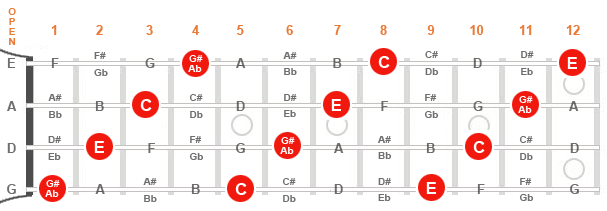
Try it with one of the other shapes.
It’s the same no matter which augmented chord shape you try.
You can put any one of the previous 3 shapes anywhere on the fretboard, and the resulting augmented chord can be named after any note in that shape.
Neat, huh?
In Review
We’ve learned how to build the augmented chord using the formula for an augmented triad: 1–3–#5.
We’ve also learned some rather unique characteristics of the augmented chord. Let’s review those:
1. Aside from a couple of convoluted efforts, there are only 3 common shapes for the augmented chord:
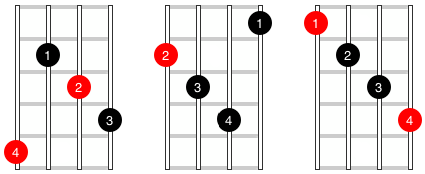
2. The chord can be named for any note it contains.
3. Each chord repeats itself every 4 frets.
But where can you use it?
Jazz and swing are certainly the first genres that come to mind. However, the augmented chord is often found in blues turnarounds, and you’ll find them in popular music as well. The augmented chord is not all that common in bluegrass, but as bands are playing more and more popular music in the bluegrass style, I hesitate to say you won’t find them in that genre, as well.
The augmented chord is something you can experiment with. Let your ear make the decision. You can put it anywhere you want if you like the sound. Consequently, It’s often used as a passing chord. In other words, use the augmented chord when moving from one chord to another (by changing a single note to move in a chromatic fashion).
Just as an example, try it in a chord progression moving (or passing) from the 1st to the 4th, or the 1st to the 5th , or the relative minor.
Try this in ¾ time:
/ A / A+ / D / D /
/ A / A+ / E / E /
/ A / A+ / F#m / D /
/ A / E / A / A /
Try using the following chord shapes for the example above. You just have to put down your second finger to move from the major to the augmented chord.
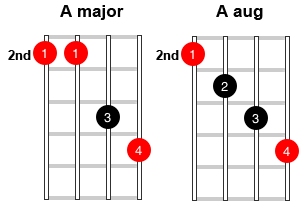
It’s a matter of 3rds
So let’s compare intervals again:
Remember, a Major 3rd is 4 half tones (4 semitones or 4 frets), and a minor 3rd is 3 half tones (or 3 frets).
Intervals used to build a Major chord = Major 3rd + minor 3rd.
The intervals used to build a minor chord = minor 3rd + Major 3rd.
When building an augmented chord = Major 3rd + Major 3rd.
Augmented chords – It is written
Augmented chords are usually written with a plus sign ‘+’ or ‘aug’ after the note letter, such as “A+”, or “Aaug”.
If you would like more info on augmented chords, check out this video.
Next, I’ll take a look at diminished triads.
